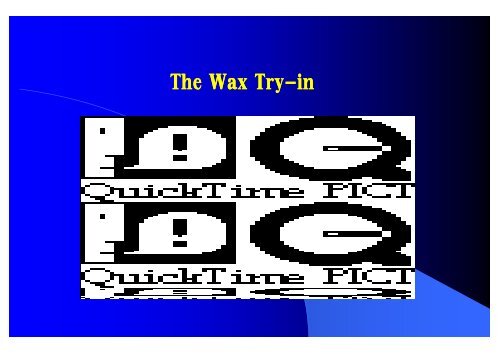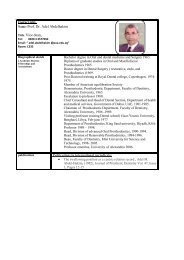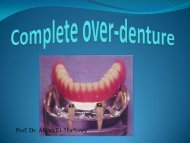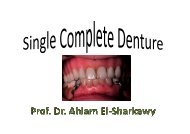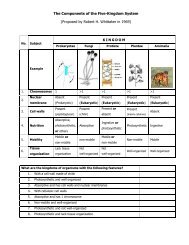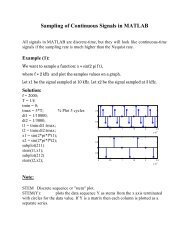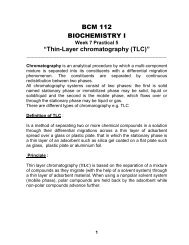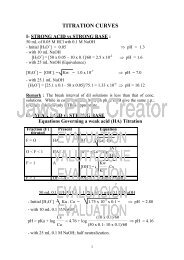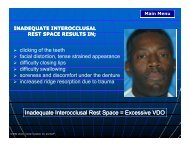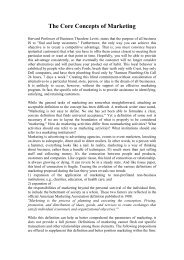The Wax Try The Wax Try-in
The Wax Try The Wax Try-in
The Wax Try The Wax Try-in
You also want an ePaper? Increase the reach of your titles
YUMPU automatically turns print PDFs into web optimized ePapers that Google loves.
<strong>The</strong> <strong>Wax</strong> <strong>Try</strong>-<strong>in</strong>
<strong>Wax</strong> <strong>Try</strong>-<strong>in</strong><br />
Verify & Change:<br />
- Appearance<br />
- Phonetics<br />
- Occlusal relationships<br />
- Patient comfort
Two try-<strong>in</strong> appo<strong>in</strong>tments<br />
• Initial wax try-<strong>in</strong><br />
- Confirm esthetics, phonetics<br />
- Verify centric, protrusive<br />
• F<strong>in</strong>al wax try-<strong>in</strong><br />
- Ensure balanced (if applicable),<br />
wax-up complete
Don’t Overlook Problems<br />
• Difficult/impossible to change after<br />
process<strong>in</strong>g<br />
• May require removal, resett<strong>in</strong>g &<br />
re-process<strong>in</strong>g<br />
• Procedures more costly & time consum<strong>in</strong>g
Incisors too long
Initial <strong>Wax</strong> <strong>Try</strong>-<strong>in</strong><br />
• Verify:<br />
- Appearance of the anterior teeth<br />
- Accuracy of the maxillomandibular records<br />
• Changes will almost always need to be made<br />
• Technician has not f<strong>in</strong>alized balance at this stage
Make Changes Technician Can’t Assess<br />
Esthetic Problems<br />
Other changes can be prescribed<br />
for the technician to complete
Verify Occlusal Vertical Dimension & Interocclusal<br />
Distance<br />
• Same techniques used previously<br />
• Critical to measure & feel 2-4 mm of<br />
<strong>in</strong>terocclusal distance<br />
• No tooth contacts dur<strong>in</strong>g closest speak<strong>in</strong>g<br />
space
Chang<strong>in</strong>g OVD<br />
• Effects:<br />
- Occlusion<br />
- Facial esthetics
M<strong>in</strong>imal Registration Material<br />
• Improves record<br />
accuracy<br />
- Less resistance<br />
dur<strong>in</strong>g closure<br />
- Reduces chance of<br />
deflection when<br />
check<strong>in</strong>g record<br />
✔<br />
✘<br />
✘<br />
✔
Alternate Technique<br />
Alluwax with a <strong>Wax</strong> Spatula
Tooth Position<br />
• Can<strong>in</strong>e Relationship<br />
- Most critical tooth<br />
relationship<br />
- If half tooth offset not<br />
present, diastema required<br />
between anterior &<br />
posterior teeth
Verify Comfort: Tongue Space<br />
Ask patient to comment on:<br />
- Comfort<br />
- Ability to speak with the dentures
Check:<br />
Esthetics<br />
- Amount of <strong>in</strong>cisal display<br />
- Harmony of the maxillary teeth<br />
with the smile l<strong>in</strong>e<br />
- Accuracy of the midl<strong>in</strong>e<br />
- Angle of the occlusal plane
Esthetics<br />
Check<br />
- Proper soft tissue profile,<br />
contours<br />
- Lip support<br />
- Display of the vermilion<br />
border,<br />
- Correct nasolabial angle
Esthetics<br />
• Ask patients for their op<strong>in</strong>ion prior to<br />
voic<strong>in</strong>g your op<strong>in</strong>ion<br />
• Avoids bias<strong>in</strong>g the patient<br />
• May be helpful to have family or friend<br />
attend the wax try-<strong>in</strong>
Esthetics<br />
If you or the patient have reservations about<br />
appearance<br />
- Resolve prior to f<strong>in</strong>al process<strong>in</strong>g<br />
- Never attempt to persuade a patient out<br />
of a concern<br />
- Problems will be yours later, if the patient<br />
does not like the appearance
Phonetics<br />
• Easier to assess<br />
- Teeth have replaced bulky rims<br />
• Crowded tongue space can<br />
adversely affect phonetics
Lisp<strong>in</strong>g<br />
• Non-uniform overjet of<br />
the anterior teeth<br />
• Diastemas between teeth<br />
• Palatal contours<br />
• Diamond-shaped<br />
open<strong>in</strong>gs between <strong>in</strong>cisors
Sibilant Sounds<br />
• ‘S’, ‘Z’‘T’ ‘CH’ ‘SH’:<br />
‘Sixty-six’, ‘Mississippi<br />
Mississippi’)<br />
• Incisors should approach end to end<br />
relationship<br />
Normal<br />
relationship of<br />
<strong>in</strong>cisors <strong>in</strong> CR<br />
Relationship of the <strong>in</strong>cisors<br />
dur<strong>in</strong>g pronunciation of the<br />
sibilants. If the lower <strong>in</strong>cisal edge<br />
is anterior or posterior the<br />
maxillary <strong>in</strong>cisal edge, this<br />
<strong>in</strong>dicates an error <strong>in</strong> the overjet.
Fricative Sounds<br />
• F, V, ‘Fifty-Five’<br />
Five’<br />
• Ask patient to count<br />
from ‘50<br />
to 60’<br />
• Maxillary <strong>in</strong>cisal edges<br />
should just touch the<br />
posterior one third of<br />
the lower lip
Denture base contours<br />
• Affect<br />
phonetics,<br />
comfort and<br />
retention<br />
• Should not be<br />
slightly convex<br />
<strong>in</strong> shape<br />
Convex<br />
Concave
Denture Base Contours<br />
Ensure that the denture base is not unduly thick or<br />
th<strong>in</strong><br />
- Excess bulk will impair comfort<br />
- Feel between <strong>in</strong>dex f<strong>in</strong>ger & thumb<br />
- Base that is too th<strong>in</strong> will be weakened<br />
- Should not be able to see through
Patient Input<br />
Use open ended questions<br />
“How do you like the appearance?”,<br />
rather than<br />
“Don’t the new dentures look great?”
Laboratory Prescription<br />
Request:<br />
- Process<strong>in</strong>g, f<strong>in</strong>ish<strong>in</strong>g & polish<strong>in</strong>g<br />
- Laboratory remount of the dentures<br />
- Adjustment of occlusion to compensate for<br />
process<strong>in</strong>g changes
Checklist<br />
• Centric record verified with record<strong>in</strong>g medium<br />
• Vertical dimension verified:<br />
a. 2-3 mm between lip closure and teeth touch<strong>in</strong>g<br />
b. Phonetics tests ("50`s-60`s" or "Mississippi") -<br />
space between rims<br />
c. Lips appear and feel unstra<strong>in</strong>ed<br />
• Tooth form, arrangement & shade verified<br />
• Phonetics verified ("S","F" and "M" sounds)<br />
• Balanced occlusion, anterior teeth only graz<strong>in</strong>g <strong>in</strong> protrusion


